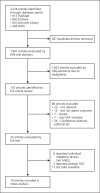Increased Risk of Liver-Related Outcomes in Chronic Hepatitis B Patients with Metabolic Syndrome: A Systematic Review and Meta-Analysis
- PMID: 34986486
- PMCID: PMC9808743
- DOI: 10.1159/000521768
Increased Risk of Liver-Related Outcomes in Chronic Hepatitis B Patients with Metabolic Syndrome: A Systematic Review and Meta-Analysis
Abstract
Introduction: Chronic hepatitis B (CHB) patients with metabolic syndrome (MetS) may present increased risk of liver-related outcomes (LROs), but prior studies were limited by small sample size and/or conflicting results. Using a systematic review and meta-analytic approach, we aimed to determine the association between MetS and LROs in CHB.
Methods: Two researchers independently screened studies from the PubMed, Embase, Web of Science, and Cochrane Library databases from inception to January 21, 2020, and extracted the data. Estimates were pooled using a random-effects model.
Results: We screened 2,228 articles and included 10 eligible studies (18,360 CHB patients, 2,557 with MetS). MetS was significantly associated with LROs overall (odds ratio = 2.45, 95% confidence interval = 1.39-4.32) but not the individual LRO components but subgroup analyses were limited by small study numbers.
Discussion/conclusion: MetS is associated with almost 3-folds higher risk of LROs in CHB and should be considered in management decisions. However, additional studies are needed.
Keywords: Diabetes; Hepatocellular carcinoma; Liver fibrosis; Mortality; Prognosis.
© 2022 The Author(s). Published by S. Karger AG, Basel.
Conflict of interest statement
Mindie Nguyen has served as a consultant or in advisory board for Spring Bank, Novartis, Gilead, Intercept, Exact Sciences, Laboratory of Advanced Medicine, Eisai, and Bayer and has received grant/research support from Gilead, Pfizer, Enanta, Vir, National Cancer Institute, B. K. Kee Foundation, and Glycotest. All others: none to declare.
Figures
Similar articles
-
Association of chronic hepatitis B infection with metabolic syndrome and its components: Meta-analysis of observational studies.Diabetes Metab Syndr. 2017 Dec;11 Suppl 2:S939-S947. doi: 10.1016/j.dsx.2017.07.020. Epub 2017 Jul 3. Diabetes Metab Syndr. 2017. PMID: 28701286 Review.
-
Associated Factors for Metabolic Syndrome in the Older Adults with Chronic Virus Hepatitis in the Community.PLoS One. 2016 May 13;11(5):e0155544. doi: 10.1371/journal.pone.0155544. eCollection 2016. PLoS One. 2016. PMID: 27177024 Free PMC article.
-
Metabolic syndrome and liver-related events: a systematic review and meta-analysis.BMC Endocr Disord. 2019 Apr 25;19(1):40. doi: 10.1186/s12902-019-0366-3. BMC Endocr Disord. 2019. PMID: 31023282 Free PMC article.
-
Association of Behçet's disease with the risk of metabolic syndrome and its components: a systematic review and meta-analysis.Clin Exp Med. 2023 Oct;23(6):2855-2866. doi: 10.1007/s10238-023-01044-x. Epub 2023 Mar 20. Clin Exp Med. 2023. PMID: 36939969 Free PMC article.
-
Metabolic syndrome and risk of subclinical hypothyroidism: a systematic review and meta-analysis.Front Endocrinol (Lausanne). 2024 Jun 25;15:1399236. doi: 10.3389/fendo.2024.1399236. eCollection 2024. Front Endocrinol (Lausanne). 2024. PMID: 38982986 Free PMC article.
Cited by
-
Coexisting steatotic liver disease is not associated with long-term liver-related events in patients with chronic hepatitis B.Gastroenterol Rep (Oxf). 2025 Feb 12;13:goaf013. doi: 10.1093/gastro/goaf013. eCollection 2025. Gastroenterol Rep (Oxf). 2025. PMID: 39944164 Free PMC article.
-
Distinct virologic trajectories in chronic hepatitis B identify heterogeneity in response to nucleos(t)ide analogue therapy.JHEP Rep. 2024 Oct 9;7(1):101229. doi: 10.1016/j.jhepr.2024.101229. eCollection 2025 Jan. JHEP Rep. 2024. PMID: 39717508 Free PMC article.
-
A Novel Algorithm for Streamlining Diagnosis of Advanced Liver Fibrosis in CHB Patients with Concurrent Hepatic Steatosis.J Clin Transl Hepatol. 2024 Feb 28;12(2):222-226. doi: 10.14218/JCTH.2023.00362. Epub 2024 Jan 29. J Clin Transl Hepatol. 2024. PMID: 38343608 Free PMC article.
-
Liver fibrosis is closely linked with metabolic-associated diseases in patients with autoimmune hepatitis.Hepatol Int. 2024 Oct;18(5):1528-1539. doi: 10.1007/s12072-024-10727-w. Epub 2024 Sep 9. Hepatol Int. 2024. PMID: 39249647 Free PMC article.
-
Impacts of metabolic syndrome diseases on long-term outcomes of chronic hepatitis B patients treated with nucleos(t)ide analogues.Clin Mol Hepatol. 2025 Jul;31(3):1003-1017. doi: 10.3350/cmh.2024.1070. Epub 2025 Mar 17. Clin Mol Hepatol. 2025. PMID: 40091278 Free PMC article.
References
-
- Schweitzer A, Horn J, Mikolajczyk RT, Krause G, Ott JJ. Estimations of worldwide prevalence of chronic hepatitis B virus infection: a systematic review of data published between 1965 and 2013. Lancet. 2015;386((10003)):1546–1555. - PubMed
-
- Lai CL, Ratziu V, Yuen MF, Poynard T. Viral hepatitis B. Lancet. 2003 Dec;362((9401)):2089–2094. - PubMed
-
- McMahon BJ. Epidemiology and natural history of hepatitis B. Semin Liver Dis. 2005;25(Suppl 1):3–8. - PubMed
-
- Marcellin P, Gane E, Buti M, Afdhal N, Sievert W, Jacobson IM, et al. Regression of cirrhosis during treatment with tenofovir disoproxil fumarate for chronic hepatitis B: a 5-year open-label follow-up study. Lancet. 2013;381((9865)):468–475. - PubMed
-
- Chen CL, Yang HI, Yang WS, Liu CJ, Chen PJ, You SL, et al. Metabolic factors and risk of hepatocellular carcinoma by chronic hepatitis B/C infection: a follow-up study in Taiwan. Gastroenterology. 2008;135((1)):111–121. - PubMed
Publication types
MeSH terms
LinkOut - more resources
Full Text Sources
Medical




